Good King Wenceslas. Wenceslas legends and Wenceslas sword. Wenceslas, Duke of Bohemia-Symbol of the ideal king, famous medieval warrior and supporter of poor souls.
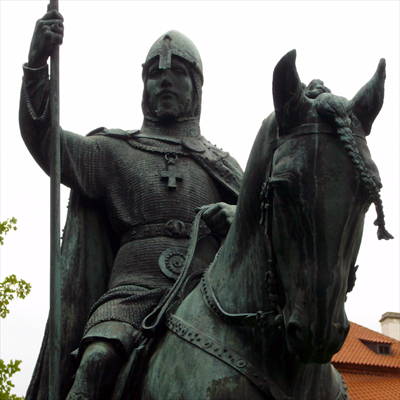
Saint Wenceslas, Duke of Bohemia, The Good King Wenceslas
Wenceslas
Many people thought the “Good King Wenceslas” song was from Britain. It is a British Christmas Carol, right? It seems that the good king was actually Saint Wenceslas I, duke of Bohemia. He may not have even been a king. He came to power in about 925 AD. During this period the Holy Roman Empire dominated the European Continent, with Prague situated its eastern edge.
Wenceslas had a pagan mother, but his father was Christian and he adopted Christianity. He is known as a great warrior, but all I could find on the internet was that he capitulated to the Holy Roman Empire without fighting and agreed to pay them tribute. Maybe he was just smarter than most warrior leaders. He became most famous for running around barefoot across winter’s snow delivering alms to poor widows, prisoners, and sick people, which is really a strange thing for a warrior king to be doing. One can only guess that he was deeply smitten with doing “good works”. This is the part of the legend that was captured in a Czech poem and put to song by John Mason Neala in England in the early 1800 hundreds.
Because of his good deeds and piety, his story spread across Europe quickly. After his death, he became a foremost example of a “Righteous King.” Hence, Wenceslas was known in places as far away as Britain. I propose his Arthur-like traits promoted his popularity, particularly in England and France. His legend even predicts that, like Arthur, he will return with his great sword and defend the land against invaders.
In September of 935 or 929, a group of bodyguards and nobles Wenceslas’ younger brother, Boleslav, murdered the Duke. After inviting his brother to the feast of Saints Cosmas and Damian, he murdered him on his way to church and thus succeeded him as the Prince of Bohemia. (Note the title Prince, indicating independence from the Catholic Holy Roman Empire, as opposed to Duke, the title granted by the Empire to Wenceslas.) The actual murder was purported as being hacked to death at the door of the church in the town now called Stara Boleslav. Boleslav become Wenceslas’ successor to the throne.
A modern Czech historian claims the death of Wenceslas was an accident caused during a skirmish between bodyguards of both brothers and Boleslav was not guilty of murder.
Although Wenceslas was, during his lifetime, only a duke, Holy Roman Emperor Otto I posthumously “conferred on Wenceslas the regal dignity and title”, and that is why, in the legend and song, he is referred to as a “king”.
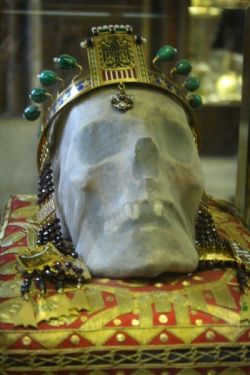
Skull of Saint Wenceslas with Premyslid Eagle
Wenceslas legends
Wenceslas was considered a martyr and a saint immediately after his death, when a cult of Wenceslas grew up in Bohemia and in England. Within a few decades of Wenceslas’s death four biographies of him were in circulation. These hagiographies had a powerful influence on the High Middle Ages conceptualization of the rex justus, or “righteous king”—that is, a monarch whose power stems mainly from his great piety, as well as from his princely vigor.
Good King Wenceslas Christmas carol (Britain)
Good King Wenceslas looked out, on the Feast of Stephen,
When the snow lay round about, deep and crisp and even;
Brightly shone the moon that night, tho’ the frost was cruel,
When a poor man came in sight, gath’ring winter fuel.
“Hither, page, and stand by me, if thou know’st it, telling,
Yonder peasant, who is he? Where and what his dwelling?”
“Sire, he lives a good league hence, underneath the mountain;
Right against the forest fence, by Saint Agnes’ fountain.”
“Bring me flesh, and bring me wine, bring me pine logs hither:
Thou and I will see him dine, when we bear them thither.”
Page and monarch, forth they went, forth they went together;
Through the rude wind’s wild lament and the bitter weather.
“Sire, the night is darker now, and the wind blows stronger;
Fails my heart, I know not how; I can go no longer.”
“Mark my footsteps, good my page. Tread thou in them boldly
Thou shalt find the winter’s rage freeze thy blood less coldly.”
In his master’s steps he trod, where the snow lay dinted
Heat was in the very sod which the saint had printed.
Therefore, Christian men, be sure, wealth or rank possessing,
Ye who now will bless the poor, shall yourselves find blessing.
Czech legend of Saint Wenceslas
Czech legend claims the Saint Wenceslas will rise at the darkest day and he will lead army of Blanik knights together with Bruncvik to final and victorious fight.
Dark days of Czech history and Wenceslas
1939 – German Nazi Army occupied Prague.
In 1945 the people of Prague revolted against the Nazi’s. The Nazi’s fought back and attacked Prague. Wenceslas square was covered in smoke and fire as the battle raged. It was a dark period but not the darkest. King Wenceslas did not rise. And rightly so, the Nazi’s were defeated and the Czech people released from the tight grasp of the enemy.
But as soon as the grip of Germany was released, a new iron grasp began to tighten around the Czech people. The Russians. In 1968 tanks rolled down the square with their tanks and forced the Czech people into submission. King Wenceslas did not rise. The motherland was darkened by the blanket of communism. For the next 11 years the stone faced King Wenceslas waited at the top of the square watching over his people. It was not yet his time. The people can defeat this enemy on their own.
In 1989 the people did revolt and gather at Wenceslas. With the statue at their side the Czech people tore of their chains and freed themselves. The Russians left the land. Czech’s became free once again.
The Good King Wenceslas still stands at the square waiting for the day to rise and save his people.
Dark days of Czechs and Wenceslas in pictures
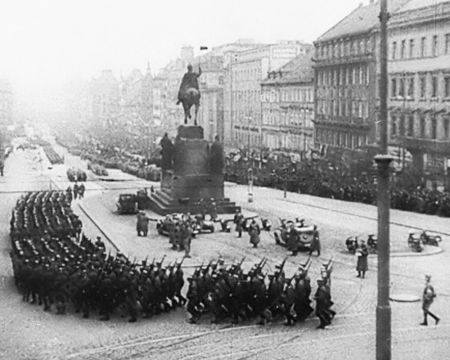
German occupation army 1939 under Statue of Wenceslas
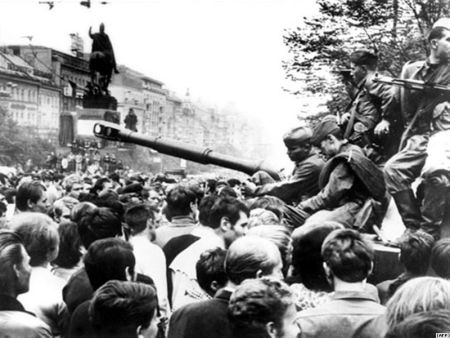
1968: Czechs facing Russian tanks under statue of Wenceslas
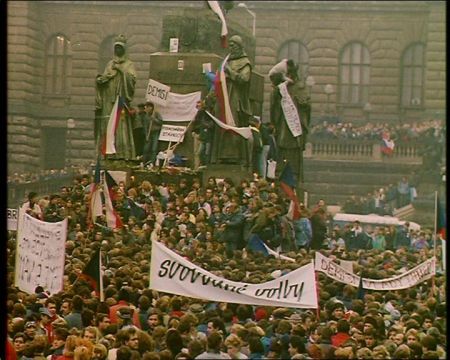
1989 Velvet Revolution under statue of Wenceslas
Sword of Wenceslas
St. Wenceslas’ sword is part of Czech Royal Jewels together with Crown of Saint Wenceslas and other artifacts. Jewels with sword are stored in St. Vitus Cathedral (Prague Castle).
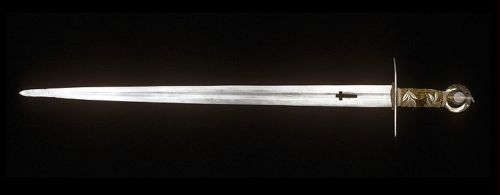
Sword of Saint Wenceslas
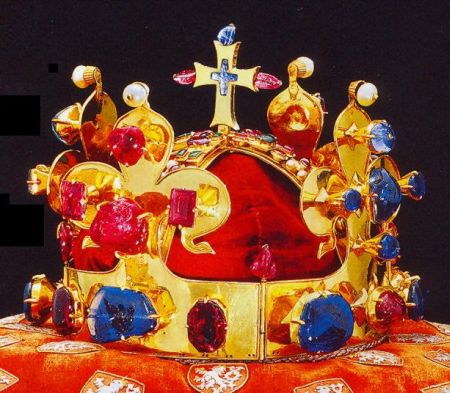
Crown of Saint Wenceslas

I have been in Prague a few years ago and i totally loved the trip.
Nice story.
I never thought Wenceslas was not a king and he was Czech.
Is this article reliable or some kind of joke?
The post is true. I saw the statue with my own eyes.
The article is definitely correct.
http://en.wikipedia.org/wiki/List_of_rulers_of_Bohemia
Scroll down, look at years 921-935 🙂
Marinka
Of course, the duke Wenceslas is from Bohemia. I am from Germany so i have to know that.
The skull is pretty weird:)
Kudos to you! I hadn’t thohugt of that!